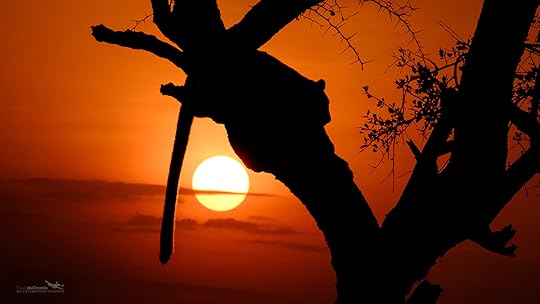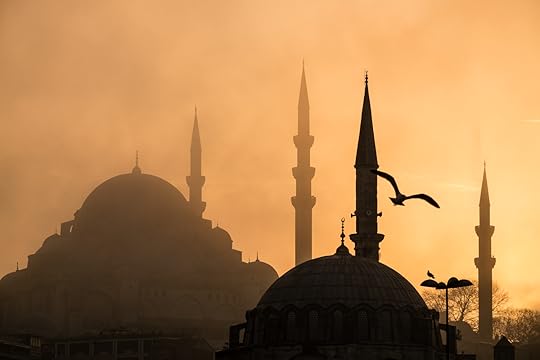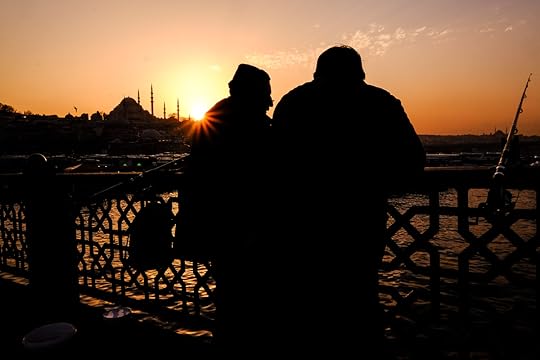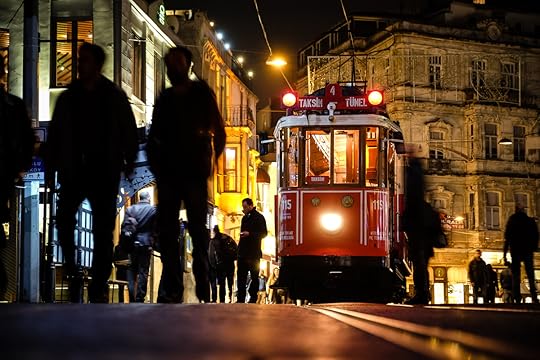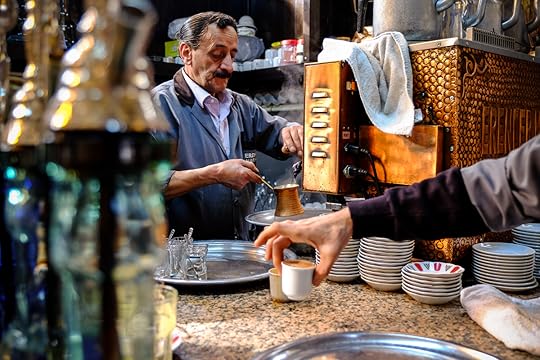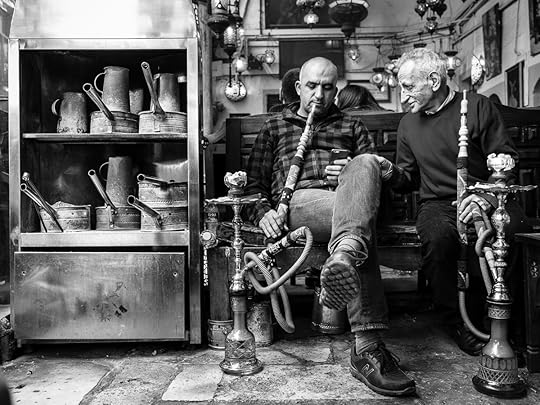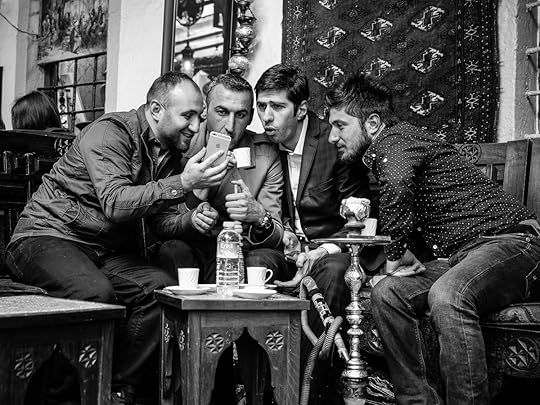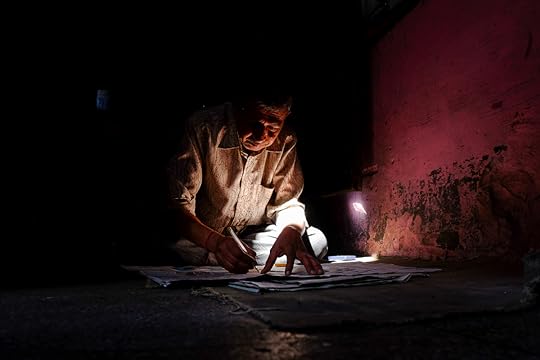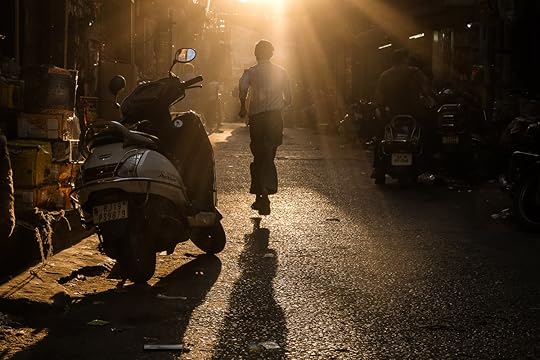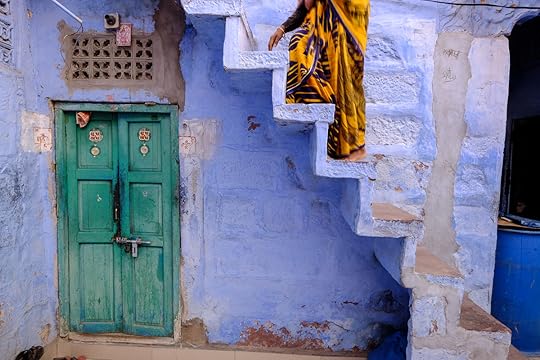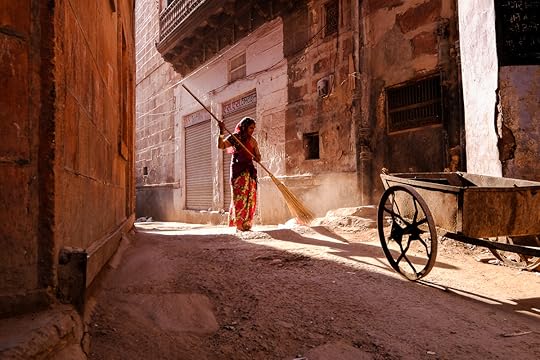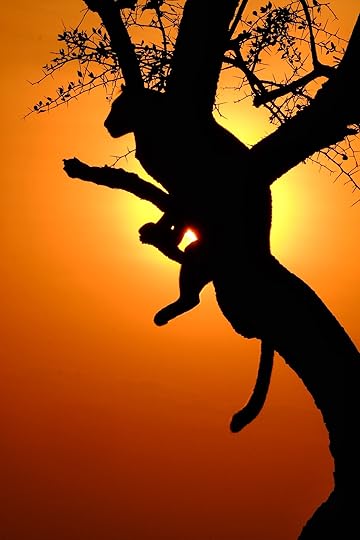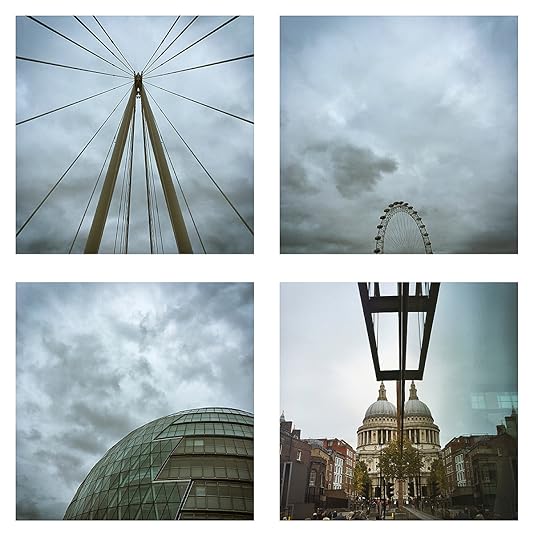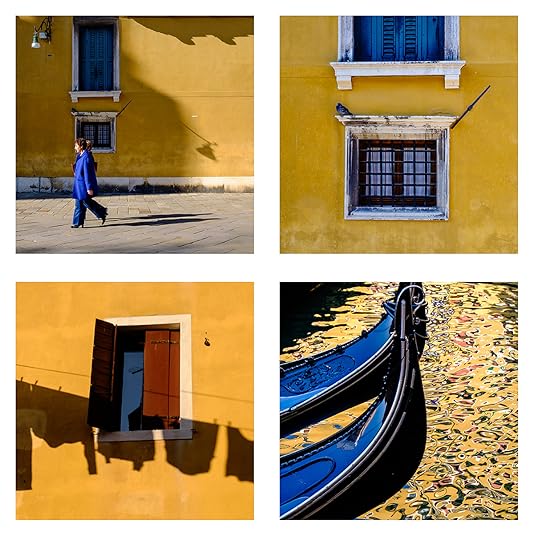David duChemin's Blog, page 11
March 8, 2016
Desktop Wallpaper: Sunset Leopard
It’s been too long since I posted a desktop wallpaper for you, somehow I just got distracted for a little while there, like a year or so. Oops. Sorry about that.
This is Fig, a female African Leopard with whom we spent one of the most magical afternoons on Kenya’s Maasai Mara recently. Watching her nap, wake to kill a passing jackal, then return to her tree to watch the sun light the sky ablaze on it’s way west, was close to transcendent. Being there to share it with friends, many of whom I knew initially only through this blog, was the icing on the cake. We’ll be going back next year, I hope you’ll consider joining us.
To download the image you can either click the image above, or follow this link to a 2560×1440 wallpaper. I hope it reminds you that there’s magic and beauty out there.
March 6, 2016
Postcards from Istanbul
I remember some point in my childhood hearing the name Constantinople; like the name Zanzibar it conjured something exotic and romantic in my mind. Of this kind of romance there was no shortage in my childhood. Early on my mother had a massive National Geographic atlas, easily the largest book in the house and I’d lie on the floor looking at the maps and wondering what was to be found in those far off places. Hemingway and Heyerdahl and Sir Edmund Hillary all figured prominently at various points as I grew up, fueling my imagination. Somehow into that imagination crept the spires of the Ottoman Empire.
That empire collapsed before I was born, of course, and it hasn’t been called Constantinople for over 500 years, but last week as I walked the streets of the city that was once Byzantium and then Constantinople and finally Istanbul, the smells of the spice markets and street food mixed with the calls to prayers lifting from the hundreds of mosques, and the bell of the tram way, and the hard-sell of the men in the Grand Bazaar, all against a backdrop of ancient spires and domes, many of them made by Sinan, one of the great architects of history. I sat with friends for long hours smoking the nargile, the water pipe known elsewhere as shisha or hookah, ate more baklava than is good for me, and drank glass after glass of tea.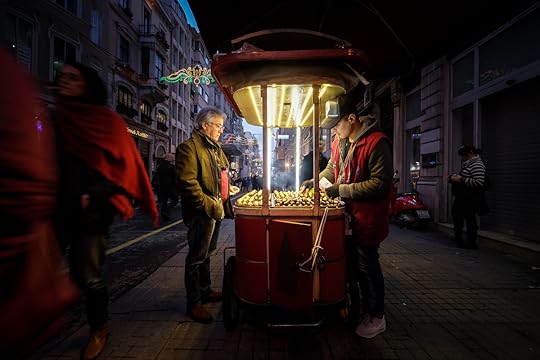
At one point, while drinking tea, I looked around the coffee shop at so many faces, most of them talking to each other, laughing, and conspiring – so connected, often touching – and I wondered what it would take to find those connections at home in the west, so many of us preferring the glow of our iPhones and laptops and disposable coffee cups. Sure, there were iPhones aplenty, and there were loners too, but by far the common desire seemed to be connection, not isolation. I want more of that.
I made a few photographs, wrote some poetic drivel, schemed my return and thought back on the last 5 weeks in Kenya, Tanzania, India, and Turkey, and felt tremendously grateful for having been there, with people I’ll now count as friends for the rest of my life. And now I’m on the final flight home to Victoria and the mounds of work that pile up in my absence, happy to spread a new Rajasthani quilt on our bed, and stay home for a while with meaningful work and great stories to keep me busy. Thanks for following the adventure and putting up with the absence. But man, what a trip. Sometimes you take a journey, sometimes the journey takes you.
Thanks most of all for being part of the how, and the why, of these adventures.
February 28, 2016
Postcards from Jodhpur
Hello from Jodhpur, though by the time you get this, I’ll be in Delhi on my way to Istanbul for one final week of wandering before flying home. It’s been a beautiful week here, full of the chaos and colour I remembered and so loved the first time I came to India and has had me coming back ever since. This trip has been a long time coming. I’m not sure what took me so long, except perhaps a growing focus on Africa and then on the west coast of Canada. I wandered markets and temples all week, introducing my four students to this incredible place, drinking enough masala chai and dal makhani to keep me powered for weeks, and generally soaking in the wonder. There is magic here, as there is everywhere if you look hard enough and are open to seeing it. But here it’s vibrant and loud and announces itself with a horn.
I’m easing into this new way of doing workshops – with very small groups of students, just 4 or 5, that I can push hard, and with whom I can spend quality time: there are just enough of us to sit around a meal table and share one conversation. Not so many that I can’t give my attention to everyone. I love it. After years of trying to find my place with travelling workshops, this is the way I want to do them from now on. If you’re interested, keep your ear to the ground, I’ll soon be announcing Venice, Florence, Rome, and a return to Jodhpur for a week that culminates with the colourful Holi festival (March 2017). When I do announce these workshops they’ll be by application only, so I can best curate the group, and they will fill very quickly. If you want to be on the email list, just leave me a comment and let me know.
These workshops, and the ones I have done before with friends like Matt Brandon, Jeffrey Chapman, and Martin Bailey who still do wonderful trips, have been one of the great gifts of my life. Most of my friends, including my wonderful girl, Cynthia, have been met on one of these trips. There are few other ways I know to bond so well with others than to travel with them.
Now I’m off to pack my bags before the sun sets over the Meranghar Fort and I need to be on a rooftop to revel in it and say goodbye to my new friends. I brought an Eagle Creek duffle on this trip that splits into 2 bags and between the incredible textiles (4 bed spreads), spices, scarves, and the gorgeous brass Ganesha figure I bought, I’m going to need it. God help me when I get to the bazaars in Istanbul in a couple days!
Share this Post, Share the Love!
February 20, 2016
Vision and Voice
I wrote a book called Vision & Voice. This is not about that. This is about the constant stream of questions I hear that all share a similar quest fuelled by a similar desperation. The questions all centre on one recurring desire: the longing to find your voice photographically.
I have tried, in my way, to answer the question creatively, given the myriad places from which so many people begin that quest, and from where they ask the question. I have also, unknowingly, skirted one obvious and uncomfortable answer.
Could it be that so many of us struggle in vain to find our voice because we have nothing meaningful to say?
As I write this I’m coming off a too-ambitious quartet of back-to-back flights from Mafia Island to Dar es Salaam to Nairobi to Dubai to Delhi. I’m tired, and I’m one whisky in to an evening in Delhi that’s been set aside to answer blog questions, write this article, and catch up with things at home after a week of almost non-existent wifi. And so it could be that this comes without my usual finesse. But that’s probably a good thing. Sometimes the more direct approach is the kindest.
What photography needs in order to become more than simply a craft, a means to say things, is – desperately – the things about which we have something to say. Without that we are not artists. We are not poets. We are not storytellers. We are technicians. And no talk of finding our voice will rescue our craft from the uninspiring – and uninspired – role it too often has. All artifice, no art. And no impact. None.
What photography needs is photographers who have a pulpit to stand on, meaningful questions to explore, beauty to reveal, injustice to expose. It needs hearts already moved by some pressing, human, thing. It needs minds set in motion by curiosity and rigour. The megapixels, on this level, are irrelevant. I suspect daVinci never wished he’d used a larger canvas for the Mona Lisa. I doubt Monet ever wished his images were sharper, more literal. Poets don’t ever strive for greater clarity at the expense of beauty or power. Those things become irrelevant in the face of touching hearts and minds with something important.
It’s important to find your voice, to discover the unique way in which you yield the camera. But that’s secondary to this: what do you want to say? What is so important to you that you want to work this craft like a rented mule, over and over again, until it says it right? What’s so important to you that you pass it on to others in your generation with pleading and the desperate hope that they hear you? Is your life so long that you have time to do anything else?
Find that. If you find your voice too, that’s icing. If all you manage, as I so often fear I’m doing, is to stammer and stutter, then do so. But don’t mistake eloquence for relevance. The heart and imagination will take a human story, true, beautiful, raw, and vulnerable, imperfectly expressed, any day over a perfect expression that signifies nothing, that has no spark.
The most important thing in the world to you. Begin there. Tell the deepest, truest, thing you can. The thing that keeps you up at night, drives you to tears, makes you erupt with head-thrown-back laughter. Only then worry about how well you tell it. Until you figure that out, all the talk in the world about megapixels and sharpness and frame rates and bokeh, is just a self-indulgent geek-wank. The heart has never in all the history of poetry or story-telling, given a flying f*ck about the rest.
Voice is a counterfeit, a fraudulent distraction from the one thing that will change your photography, your writing, or any other thing you do with these quickly-passing bays: vision. A way of seeing. A thing to say. Find that. The rest will follow.
Share this Post, Share the Love.
February 10, 2016
My Gear Shift
Once in a while I abandon all sense and do a gear post. This is one of them. I hope it’s helpful to you and that you find the question of why I use the gear I do more interesting than which gear, specifically, I use. It’s the one question that seems to get left out of these discussions; everyone talking about which gear is best without first defining their needs. As so many of you are making similar switches in the way you approach your work, I thought I’d walk you through mine.
Last month Fuji announced 2 pieces of gear that pushed me over the edge. As many of you know I’ve been using Fuji cameras more and more, but still hanging on to Pelican cases full of Nikon gear. I’ve held out on switching completely (almost completely, but I’ll explain that) because the Fuji system lacked any optical options at the long end – specifically something more than a 300mm equivalent- and I need those more and more for the work I’m doing.
With the 100-400 lens that has now changed, giving me (a) a zoom lens instead of fixed primes that force me to fumble with teleconverters and (b) at the long end a 600/5.6 equivalent. That lens is fantastic. And it weighs less than my Nikon 70-200/2.8. And it’s got 5-stop Image Stabilization that means I can make tack sharp images, handheld, at very reasonable shutter speeds – down to 1/15. And it’s weather-sealed. So that’s the first piece. I can now carry 2 cameras, and lenses from 16mm to 600mm (35mm equivalent) in a carry on, with batteries and related things, that weighs less than 18lbs. As a traveling photographer who is less able to carry all that weight, this is great. And as carry-on allowances shrink, and small planes, like the ones I use on safari or coastal BC, have the usual tight weight restrictions, it means less worry about checking a bag, or not being able to bring it at all. The lighter kit means I can walk all day on my arthritic ankles and still have the energy to create and walk down one last alley or peer around one more corner. On top of this, the full range of Fuji lenses is optically excellent.
A 1:1 preview of one of my images shot with the Fujinon 100-400. All the sharpness I could ever ask for. After a week on safari, using this 100-400 lens daily I’m ready to unreservedly switch.
The second piece of gear Fuji announced is the X-Pro2, a 24 megapixel mirrorless camera that will, I am sure herald the coming of the 24mpx version of my much-loved X-T1. You know I’m not bent out of shape about how many pixels I have – for years my favourite camera was my Nikon D3s, a gorgeous, heavy, fast, workhorse that never failed me, but only gave me 12-pointsomething megapixels. And no one ever asked me, aren’t you worried your images will be too small? But I crop to 16:9 and 1:1 often enough that re-gaining some of that resolution is a gift. And so I sold off my Leica M, kept some of my favourite lenses from that system, and can get the best of both worlds – 24mpx body, but full autofocus, and the option to still use, for example, Leica’s beautiful 21mm lens that I adore. The X-Pro2 also has, finally, dual card slots. And for the now the 16 point something megapixel XT-1 will continue to serve me well. I don’t need to print billboards. Most of you don’t either.
Fuji cameras are quirky. But getting less so. And nowhere near as quirky as the Leica M. They are fast. I don’t photograph sports and when I photograph wildlife it’s not usually the action stuff I’m trying to capture, but for me they are ample fast. Even with my Nikon gear it wasn’t my gear that slowed me down, it was my own reaction time. The Fuji X-T1 is weather-sealed. It has an articulating LCD so I can shoot from weird angles and interesting POVs without having to lie down in puddles. And the image quality is amazing. And with wifi image sharing I can fire a JPG to my iPhone to share work with clients or on my Instagram feed.
I get asked if I miss the full-frame advantage, but to be honest it’s not a consideration for me now. It once was. When my 24mm lens acted more like a 35mm lens and I wanted something wider to accommodate for the crop, it mattered. But to me the two advantages full-frame would give me are (a) the access to a full range of focal lengths and (b) the softer depth of field at wider apertures. The lenses are now available to cover me just fine, and increasingly I have no desire for the really wide, dreamy soft background. Even with an f/1.2 lens I’d likely only shoot it fully open if light were an issue. It rarely is. It used to be. A couple years ago I’d almost never use anything higher than ISO 800, so the /1.2 lens was great and I’d shoot at /1.2. But it wasn’t easy. And it was heavy. Now I can shoot with lighter, smaller lenses and push the ISO a little, and keep a little more in focus (and, to be fair, the Fuji 56/1.2 is plenty dreamy when used wide open).
What matters to me now is that my cameras get out of the way as quickly as possible. For me that’s the Fujis, as opposed to the Olympus or the Sony systems, because only Fuji has the old-school ergonomics that are so second nature to me – aperture on the lens, shutter speed on a dial at the top of the camera. And I think the quality of the images from the Fuji Trans-X sensor is exceptional in the ISO range I need, generally never over 1600. 3200 gives me the jitters. Some people need that. I don’t. When it’s that dark I go to bed. Add to all these benefits the fact that much of the gear I now used, compared to the gear I was using, is much less expensive. The Nikon 300/2.8 costs USD$5500 new. The Fujinon 100-400 costs USD$2000. It’s not a perfect comparison, but in terms of the options I am working with right now, I can sell my Nikon gear in USD, which is killing the Canadian dollar at the moment, and use that money to completely replace my gear – with gear that works better for what I need right now – and still have enough left over to go diving with sharks in June or photograph grizzlies in May. I’d rather do those things than own a bunch of high-end gear and not be able to afford the experiences. For me the experience always trumps the gear, because the only reason I buy the gear is to photograph the experience. Lighter, cheaper gear that gets out of the way quickly wins every time.
If you need to, read that last paragraph again. I’m not suggesting Fuji cameras are better than the Nikon DSLRs that I love. I’m not saying the latest and greatest from Canon are not spectacular. They all make photographs in slightly different ways, and the technical nature of those photographs will all differ, in size, dynamic range, and really any other criteria you can list. The question isn’t “which one is better,” it’s which one best fits your needs. This is important. These incredible cameras, of any brand, will not compensate for a lack of vision or for a lack of craft. They will only make my photographs better in the sense that they let me do what I do with the fewest possible barriers. That is how you choose a camera.
So now, with the exception of 2 Nikon D800 bodies and a Sigma 15mm fisheye and a Nikon macro lens (105mm, if I recall), which I use with my Nauticam housing for scuba work, my Nikon system is getting slowly sold off. The 300/2.8 and extender will be the last to go, and I’ll be selling them when I get home (they’re already spoken for).
Remember this: there’s no perfect system, and there is no system that does it all. There are always compromises. You ask yourself which compromises you can live with, even use to your advantage, and which ones you can’t. And you separate your needs from your wants. I want a bad-ass pro-sized body that looks cool. But I need a camera that I can carry all day. I wanted to keep using the Leica M I sold, but I needed a camera that will focus quickly and in low light, which my Leica – in my hands – didn’t always do. The best camera is the one you have with you, but it’s also the one that does what you need it to. And your needs might be very different from the needs of others, so figure that out first.
As for what’s in my kit now, in terms of cameras and lenses) here’s what’s in bag these days, though I’ve also included the X-Pro2 which is still on its way. The items with an asterisk are the ones in my bag right now on this trip which includes a 10-day safari in Kenya, diving in Zanzibar (without my full dive rig), a week in Rajasthan, and a week in Istanbul
2 x Fuji X-T1 bodies*
1 x Fuji X-Pro2 body
Fujinon 10-24mm/4.0 (equivalent roughly to 16-35mm)*
Fujinon 16-55mm/2.8 (equivalent roughly to 24-85mm)*
Fujinon 56/1.2 (equivalent roughly to 85mm)
Fujinon 55-200/3.5-4.8 (equivalent roughly to 85-300mm)
Fujinon 100-400/4.5-5.6 (equivalent roughly to 150-600mm)*
For this trip I’ve also got a Canon G7x for podcasting, should the mood hit, and a Sony RX100II which I’ll use with a small Nauticam housing to dive. Add twenty 64GB SD cards, 8 batteries, and an extra 1TB external hard drive for my 13” MacBook Air, and that’s my full kit. Almost all of it goes into my Think Tank Photo Airport Essentials bag to travel and I work out of a couple different satchels, none of them actual camera bags – just simple, light, satchels into which I can throw lenses wrapped in something, along with a couple batteries, a sweater or a light rain jacket.
Questions? I’m happy to do my best to answer them if you leave them in the comments. I’m not sponsored by Fuji and I hope by now you now that my love for one camera or another is measured only by how much I love the photographs it lets me make.
Share this Post, Share the Love.
January 26, 2016
See The World for $12
Last year I wrote SEE THE WORLD, 20 Lessons for Stronger Travel Photographs, a book about seeing and photographing the world. You could call it a book about travel photography but I think it’s more than that. Bob Krist, a veteran travel photographer who works for National Geographic and whom I include as a case study, along with Art Wolfe, called this book “The thinking person’s guide to doing what we do.” I don’t think I could have asked for higher praise. And then I added a second resource, a full case study from my work in Northern Kenya.
You won’t get a better deal on this. It’s almost 300 pages, and a 17 minute companion video, about what I consider the real goods on travel photography. The two books cover discussions from gear, and getting there, to composition and creative processes, photographing people, and the ways in which we slow down and truly experience a place. I don’t say things like this very often but this might be the best $12 you could spend on your photography education. And if you aren’t there yet, you can still get plenty of free educational resources, like my eBook TEN, Ten Ways to Improve Your Craft Without Buying Gear and its sequel, the very cleverly titled, TEN MORE. There are also over 60 podcasts, some audio and some video, here and they too are all free.
Seeing this world, and experiencing it as deeply as I can is my great passion. Having a camera in my hands while I do it, so I can share those adventures, is just the icing on the cake. Thanks for being part of that with me. If you didn’t get SEE THE WORLD when it came out or you were waiting for it to come around as the Deal of the Week, now’s your chance. It’s only $12 until 11:59 PST on February 03.
These images are from my recent travels, and while they are representative of the kind of images that you’ll find in the books, these particular ones aren’t there. I just thought I’d let you look at them. In housekeeping news, I head to Kenya this week – finally – after I threw my back out at the beginning of the month and had to cancel travel plans to South Africa and Lesotho. I’ll be on the road all February – in Kenya, Zanzibar, Rajasthan, and Istanbul – and will send postcards as I can!
Share this Post, Share the Love.
January 24, 2016
What’s Your Potato?
It’s a slow Sunday afternoon. Coffee’s on. Van Morrison is mumbling his way through The Healing Game album. I head to Africa (finally!) at the end of this week after a three week delay. I’m restless. When I’m restless I write. And I’m hoping this time it sticks because I’ve written and re-written this article several times now, unable to get at the very core of what I want to say.
The big headline this week in photography circles is the sale of a photograph for $1 million. A photograph of a potato. I’ll give you a second to make a comment about how you could do better or how your kid puts better drawings on the fridge and doesn’t charge you anything. A million dollars!
But here’s the thing. Most people that look at the work of most photographers say the same thing. They will say it about your work, and they’ll say it about mine. Yes they will. Because the value of what you do is not – in the marketplace of the real world – ultimately what you say it is. It’s what your market says it is.
Some of us will take umbrage with this and write articles -usually on Facebook where academic rigour and common sense resonate less than volume – about how photographers on Craigslist are undercutting us all and how we can’t photograph a wedding for what the market will pay because our gear, our studio, our insurance, and our time, cost so much money and how we need to feed our kids and take the cat to the vet and you know what? All those arguments are true.
But nobody cares. Nor is it their business to care.
Your clients don’t care how much your gear cost. They don’t care what your bills are. They don’t care if you go bankrupt. Those things are not their concerns nor should they be. And it’s not the responsibility of the young photographer down the block doing sessions for $50 so she can cut her teeth on this craft, to plug the holes in your faulty, out of date, business model.
Your clients, if they are to be your clients, care about the things they care about. The default mode of photographers is to try to convince the market to care about things we think that market should care about. Our default mode is a defensive position. Instead we should be listening.
Why aren’t people paying you $10,000 for your wedding photography? There are probably two reasons. The first is that they don’t value photography the way you do. You’re trying to sell them a Rolex and they’re very happy with their Timex. The second is that you haven’t found something they value more than the $10,000 you’re asking them to part with. In short, you have no potato. Find out what they want. And then connect that, if there’s a connection to be had, with what you do well.
Value is at the intersection of what you do well and what the world wants. The more they want it and the better you do it, the more they will exchange for it.
Earlier this month Vogue told readers that among the things a modern bride and groom can do without is a professional photographer. Photographers rushed to the ramparts with flaming arrows to defend the castle. And some of what got said in defence of vocational photography was the undeniable triple truth. But. The one question I don’t see photographers asking, because that article was a profound opportunity to better understand that market, is “what can we learn from this?” Or more to the point, “what does my market or potential market value, and how can I change what I do, and how I do it, to give them that value?” The first ones to re-jig their business based on the never-ending re-mixing of what we are good at and what others want, will win. The last ones out of the gate, because they’re too busy defending what “ought” to be, and what markets “should” value, will lose. They will lose the attention of their markets because they don’t listen to them. How could they? They’re too busy trying to sell them something they don’t want. The question for the open-minded should not be “how many ways is Vogue magazine wrong about this?” The question should be, “what if they’re right?”
Is a photograph of a potato worth a million dollars? That’s not for you or me to decide, ultimately. It’s for the buyer. But I guarantee the photographer, in this case it was Kevin Abosch, a photographer who also charges up to $500,000 to make headshot of people like Johnny Depp, didn’t make his case by telling the buyer how much his cameras cost, and looking nervously over his shoulders for a Craigslist photographer who has a photograph of a yam for sale for $50.
We should be inspired by Kevin Abosch, however absurd we consider his photograph. It should give us hope. It should light a fire under our ass. It should make us take stock. And it should make us ask long, hard questions about our audience and what they find valuable. But it’s easier to mock. It’s easier to huddle together and snicker. Much harder to, instead, go looking for your own potato. Much harder – because this wasn’t Abosch’s first potato photograph – to keep photographing that thing over and over and over until someone bites. It’s much harder to do the work. To study branding and marketing, to fail, and reinvent yourself when the market changes as it most certainly has over the last few years.
To be blunt, in the most loving, friendly way I can, because this sermon, like most of the sermons I preach, is first aimed at myself – the world owes us nothing. And as more and more talented photographers jump in the pool the laws of supply and demand will mean there’s more supply, less demand, and for the commodity that is most abundant, the value will drop. So we – you and I – sure as shit better have something more than a mere commodity to offer. It’s hard as nails to make a living by charging for something others will gladly do for free.
What’s your potato? And who wants it? If you can’t get past the fact that it’s “just a photograph of a potato” then you understand exactly how much of the market feels about your work. About my work. And until you understand the value you offer, and understand that value is entirely in the eyes of the buyer, your only position will be a defensive one. The question is never “how much are these photographs, or my ability to make them, worth?” The question is always, always: “does my audience see value in what I make?” I will know the answer not by how loudly I proclaim my worth (and you must also believe in that), but by how much time, attention, and money, your market or audience, is willing to trade for it.
Share this Post, Share the Love.
January 15, 2016
Garage Sale Gear
Once in a while I do a purge and get rid of some gear. Today is that day. If you’re looking for some good deals on some specific gear, this might help. Everything is in good working order, I wouldn’t sell it if it weren’t. If I don’t sell it, I will just keep using it. Like all working gear there are cosmetic, uh, enhancements, but nothing that affects the working of the gear and I’ll be completely up front with you if you’re interested.
Leica M(240), black , with lenses. I’d prefer to sell this as a kit, though I’ll sell the lenses separately if needed. A beautiful black Leica M(240) with 4 batteries, Really Right Stuff grip and L-plate, Leica EVF, leather strap, soft-release (red), and two SUMMARIT-M lenses – the 50/ and the 90/2.5. Over USD$11,000 worth of gear. Yours for USD$9,000 and I’ll deal with shipping. No original boxes.
Fuji X-E1. I have two of them. If you’re interested I’ll tell you what kind of condition they’re each in, and what kind of extras they have. Body only, both black. You can get these new for about USD$500, body only. These are $USD300, plus insured shipping. No original boxes.
I also have a Fujinon 14mm and Fujinon 18/2 lens and will let these go cheap – USD$400 each, plus shipping. No original boxes.
Nikon D3s, body only. Great camera. Fast. I have two and will keep one. B&H has them used for USD$2500. Buy this one for USD$1800. Body only, with arca plate and I’ll include 2 batteries. Pretty sure I have a box for this one.
Zeiss Planar T 50/1.4 for Nikon. Manual. Yours for $450. No original box.
Nikon PC-E 24mm/3.5 Tilt/Shift. New it’s USD$2200. Yours for USD$1400 plus shipping.
I’m selling this stuff because I have too much, haven’t used this gear lately, and I’m hoping it will serve someone better than it does me sitting on shelves right now. It just kind of crept up on me. And because I’ve got some expensive adventures planned in the near future and I’d rather do those than keep these on the shelf.
If you’re interested in any of it, let me know in the comments. I’m here until the end of the month and anything left after that will have to wait until mid-March when I’m home again. Help me find a home for this stuff?
January 7, 2016
Photographic Memories: Russia
It was January 1992 and the Iron Curtain had fallen so recently we were all still blinking our eyes. The cold war was over and I was in Russia, shivering through one of the coldest winters of my life, brought there by idealism and delusions of Dr. Zhivago. I lived that winter in an apartment in Yaroslavl that was colder inside than out, despite having dispatched two large rolls of duct tape in a bid to keep the winds and fine snow from blowing in through windows that seemed to amplify the ferocity of the weather outside. The mornings were so cold we’d take turns drawing a hot bath and getting in, still in our full length union suits, not so much to bathe as to warm up. God help you on the mornings it was your turn to wait for the water to heat up and make its way through the rattling pipes to the massive rusting bathtub. A man could freeze to death in less time.
Idealistic young theology students, we spent our days bringing faith to the godless Russians, a little disappointed to find faith was not only already there, but more robust and tested than any faith I could claim as my own, then or now. We preached under banners of Lenin’s likeness, rich red velvet embroidered with CCCP in gold, still waiting to be taken down and replaced with nobody yet knew what. It was an astonishing time of change. Not everyone made that transition particularly well. We were not the only ones.
The young man that approached us in St. Petersburg was clearly wrestling with the finer points of free-market economics, new as it was, when he approached my friend and me asking for change, which we’d have gladly given him were we not – dressed in the layered winters clothes and torn blue jeans of the dirt-bag climbers we were at the time – on our last dimes ourselves, trying to make them last until we flew home later that week. He repeated his request, and we repeated our polite decline. We did this a few times, the exchange getting less and less polite. To our relief he finally turned to walk away, then – much less to our relief – turned back, a thin razor blade in hand, and said, “Your money or your life,” which would have been much more ominous had it not sounded so much like a line from a bad movie, and had we not been wearing every layer of clothing we owned. His blade, double edged and rusty, seemed to pose more of a threat to him than it did to us. Cutting us deeply enough that it would induce us to part from our pocket-change, would have taken not only an act of compliance but of collaboration, from us. We declined. He became more agitated. And then he left.
Sort of. He walked away, down snowy sidewalks filled with art, the kind that’s framed and ready for tourists to take home. We watched him go, nervous he might come back. Which he did, but not before he looked nervously in both directions, pulled a framed painting off an easel, and stuffed it into his overcoat before striding back to us.
“You want to buy painting?” he asked.
The subtlety of his approach has probably been refined in the years since that incident. I wish to this day that I’d bought the proffered painting, pilfered as it was, if not for the art, then for the memory. What I did buy on that trip was an antique samovar, an elaborate tea kettle unique to Russia. It was large, heavy, nickel-plated, and bought after no small negotiations with an investment of both rubles and time. It was a surprise then, when, the customs official in the large grey great coat and rabbit-fur hat, pulled it from my duffle bag at St. Petersburg airport, with the look of a man who saw an opportunity and a sucker. Putting my various knick-knacks back in the bag he said, “Souvenirs, no problem.”
“But samovar,” he said, “samovar, big problem.”
“In Russia,” he said, “we have 200% duty.”
He never asked me how much I paid for it. Instead he reached into his great coat and pulled from it’s vast interior a ziploc bag, which he opened to reveal another ziplock bag. This he opened, revealing another ziploc bag. He left this closed, the calculator inside as safe from moisture as the coming calculations would be from logic. His thick fingers flew across the buttons furiously. I’ve seen quantum physicists make calculations with fewer variables.
“Ten dollars!” he said triumphantly, before looking confused, disappointed, and declaring, no, in fact, that was not correct. He pounded more buttons.
“Twenty dollars!”
I gave him my last two ten dollar bills which he shoved into his pocket with the calculator and his collection of ziploc bags, before pushing the samovar and the spilled contents of my bag into my arms, saying “You go now!” before looking nervously over his shoulder and walking away, no doubt to spend his new-found fortune on caviar and vodka.
Two strangers tried to take me for all I had and left me with stories for which I’d have paid so much more. The photographs of that trip, forgettable as they are and still on slides, are like bookends to the much more interesting moments, as if the camera (a Pentax PZ-10, as if it matters) served only to get me there. These moments, and so many more, are why I chuckle when new cameras come out and the hordes run to praise them, buy them, and review them only to find to their surprise, they’re just like the others that came before them. Boxes of plastic, metal and glass, soon obsolete, and only as interesting as the lives lived by their owners, and the photographs they make.
January 5, 2016
After The Camera Live(ish)!
I should be on a plane to Lesotho right now. I’m not. A back injury is keeping me from an adventure I was really excited about. I’m trying hard not to be totally bummed about it. But my loss is your gain because, friends, I’ve got nothing but time on my hands
So January is now Vision-Driven Workflow month. We launched After The Camera in the first days of January and I figure those 20 episodes ought to keep you busy for a while. But I also figure they might lead to some questions. So I’m going to use this time to get answers to those questions for you.
Now, I’m assuming you’re working through the AFTER THE CAMERA material – I spent a lot of time making it and the last thing I want to do is answer a question I have been pretty clear about in the videos. The 20-episode video series is still on sale for 25% off – making it still only $30. Now’s your chance. But if there’s something I can clear up for you, or perhaps a RAW image of your own that you’d like me to take crack at, I’d like to try.
This is highly experimental, but here’s how I’m hoping it’ll work:
LEAVE A QUESTION, as clearly as you can in the comments below or in this Facebook post. This has the potential to get out of hand if questions get left in a million places so only questions left in these two places will be answered. (Follow this LINK to Facebook)
SUBMIT AN IMAGE (OPTIONAL) I can only do a few of these but if you want to submit an image of your own and see how I’d approach it, submit an image link from Dropbox. You can give it to me in RAW or JPG, but the only way I will receive these is if you put a Dropbox link into the comments below. I won’t take emailed RAW images for obvious reasons.
WATCH THE VIDEO REPLIES. I will answer your questions by creating a handful of videos that I’ll post on the Craft & Vision You Tube channel. I will answer as many of the questions as I can and – depending on demand – release a couple episodes of Vision Is Better on my YouTube channel each week. Subscribing to the You Tube channel will just make sure you know when a new episode gets posted, so you don’t miss a thing. So depending on how this goes, your $30 purchase of this video series could get another couple hours of helpful additional material.
You can find the VISION IS BETTER show on my YouTube channel here.
And you can find the AFTER THE CAMERA series here, and still on sale for a week or so.
My hope is of course first to be helpful. I enjoy these times when we get to connect in some way. The more valuable I can be to you the happier I am. But I’m also hoping that you’ll see enough value in the After The Camera series, and these Live(ish) Q&A videos that you’ll want to share the love and tell others.This is part of how I make my living and the vast amount of sales come from people like you who honestly and enthusiastically recommend my resources to others. As always you have my gratitude for letting me be a part of your creative journey.
So, who’s first? What are your questions, frustrations, etc. about editing, organizing, and post-producing your images in Lightroom? I’ve got nothing but time friends, let me know how I can help.
Share this Post, Share the Love.

